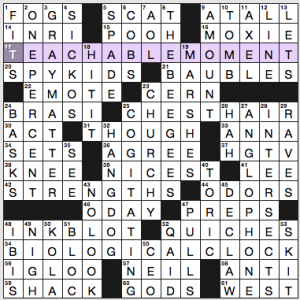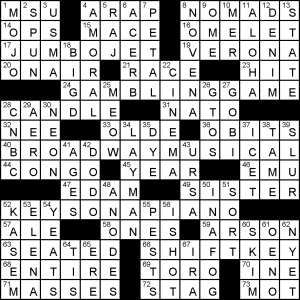No CHE this week. The next one is on August 5, and then weekly puzzles resume on September 2.
John Guzzetta’s New York Times crossword—Amy’s write-up
Solving time inaccurate, as I was listening to Chelsea Clinton while working the puzzle. Maybe a tad harder than the typical Fri NYT, and maybe right on target. Who knows?
Let’s see. What did I actually absorb while solve-TVing? Likes: MOXIE, great TEACHABLE MOMENT, SPY KIDS, BAUBLES, QUICHES, BIOLOGICAL CLOCK, the ONE PERCENT, GRAY MATTER, HANGDOG expression, a little COGITATING, CHURCHY, THE BEE GEES (check out this a cappella performance in 1998 on a TV show, these brothers had some pipes!), and ANGLOPHONE.
Clues I liked:
- 59a. [Roughhouse?], SHACK.
- 60a. [Eponyms of the week?], GODS. E.g., Tyr, Odin.
- 12d. [Shoppers’ headache], LINE. Do you have a knack for choosing the worst line? I do.
- 19d. [Rail hubs?], MARSHES. Rails meaning birds, not train tracks.
Clues I didn’t much like:
- 18d. [Cry after “One, two, three,” maybe], “HIT IT.” Better if we didn’t have ONE PERCENT at 2d.
- 45d. [Make furniture-safe, in a way], DECLAW. It’s basically amputation, you know. Ow.
- 25a. [Symbol of virility], CHEST HAIR. Meh. Plenty of virile men are smooth-chested, and there are also women who have some wiry chest hairs but are not remotely virile.
Overall, solid fill, mostly good cluing. Four stars from me.
John R. O’Brien’s LA Times crossword – Gareth’s write-up
I think it’s safe to say solving this on ones PC made the theme considerably easier. Even without that, I found the rest of the puzzle much easier than most Fridays, except for the small top-right, where I struggled for traction.
The conceit is two-fold. First, we have clue-answer reversal where each clue is a number. This is further obfuscated by transcribing them using the letters above them on a keyboard – accessed by pressing the SHIFTKEY when typing them.
I appreciated 3/4 of the theme answers: [747] is a JUMBOJET; [21] is a GAMBLINGGAME; [1776] is a BROADWAYMUSICAL. Those are all, broadly, things known by numerical names. [88] is the KEYSONAPIANO – odd man out, and the most awkward answer to boot.
Some interesting trivia clues today:
- [Ancient time-telling device], CANDLE.
- [Hastings Ismay was selected as its first leader…], NATO.
- [Carroll’s stammering self-caricature…], DODO.
Other notes:
- [“She loves me” bit], PETAL. Wasn’t paying enough attention and put YEAHS at first – as in “She Loves You”.
- [Multi-day devotion], NOVENA. Not knowing this vocab word made that section very difficult!
- [Bubbly-textured Nestle chocolate bar], AERO. Very common here, and if I were writing crosswords for a South African audience this would be my go-to AERO. I was under the impression it was not sold in the U.S., except occasionally as an import (in the same way there is one shop here selling Reese’s Pieces, but at 6x what any local chocolate costs… Too pricey just to try it at those prices!)
- [Hall of Fame golf course architect Pete], DYE. Also, [Hall of Fame golf course architect Alice]… Creators of among others TPC @ Sawgrass and Whistling Straits.
Definitely a more interesting and layered puzzle than most, with just the one weak theme entry as a demerit.
3.75 Stars
Gareth


With MARcHES instead of MARSHES and ??EcT???? for [Symbol of virility], you’d better believe I put erEcTions in my grid before CHESTHAIR. Whoops?
NYT:

Yes! I thought of the same thing. This movie is absolutely hilarious. I can hear Joe pesci saying “not to mention your *tap tap* biological clock”.
whoa. did not know we could put gifs in the comments!
my time would’ve been faster if I didn’t immediately put WALLSTREET and then INEQUALITY in at 2D. oh well! good solve anyway.
Hand up for starting with WALL STREET as well, but at least that helped with SETS and STRENGTHS. Though I know mini QUICHES can be served on a platter as hors d’oeuvres, it’s certainly more common to find them as pie slices, no?
WALLSTREET here as well. And once I realized it was wrong, I was just waiting for it to show up somewhere else in the grid since it seemed almost an intentional possibility.
Also never heard of birds called RAILS. Thought I was past that stage in solving. Alas, guess you’re never too ______ to learn.
This went unusually quickly for me, by Friday standards. My only holdup was that I had to run the alphabet to figure out the QAI_/GO_S cross, but even then it was the fourth letter so didn’t take long.
I would have put WALLSTREET in except that I already had BRASI so I could see it wouldn’t fit.
“Many gases lack them” is a strange clue for ODORS. Could equally well have been “Many gases have them.” I don’t know if anyone compiles statistics on whether gases are odoriferous or not. I would guess that there are more smelly ones than unsmelly ones, once you start getting into complex organic molecules.
MARSHES for “Rails hubs” was nice.
Yes, the clue would “work” either way.
My guess is that more gases are odorless than have an odor. The reason: in order to bind to an olfactory receptor, a molecule has to have the right shape, which generally means it is important enough to our survival (or to that of an evolutionary ancestor) for us to evolved a matching receptor. These are usually substances to avoid as toxic or molecules that signal the presence of food. We can add pheromones (sexual attractants) to the discussion. They are critical for many animals but their importance to humans remains controversial.
Some chemicals are detected by our nose because they are so caustic that they can damage our olfactory system. But most are sensed because evolution has taken the pains to make them recognizable. The vast majority of molecules are not important for us to detect, so remain odorless.
I don’t buy that argument. Olfactory receptors are often sensitive to a particular molecular group rather than a whole molecule, and may have sensitivity to closely related groups. Plus there are a gazillion of them. The fact that a molecule isn’t encountered in nature says nothing about whether we might be able to smell it or not.
Olfactory receptors are sensitive to a large number of molecules, from very few chemical families. Esters, terpenes, aromatics (compounds derived from benzene rings), amines, a few sulfur compounds, and a few aldehydes and ketones comprise the vast bulk of odorants. Evolution is very efficient. A gene for a receptor for a family that we don’t encounter in our environment would not be conserved. We can’t smell aliphatic compounds, for instance, or any of the gases in air. To do so wouldn’t offer a survival benefit in our original habitat. It would today, but we make do by adding mercaptan to natural gas.
Odors don’t just “happen.” They exist because we have evolved a mechanism to detect important air-borne molecules.
BTW, the whole question of which molecules have “odors” is very subjective. In general, women can detect and discriminate between odors better than men. Babies can “smell” their mothers but lose that ability as they develop. Women have different sensitivities to odors at different stages in their menstrual cycles. We have 350 genes for olfactory receptors; mice have 1,300. Mice think there are three times as many gases with odors than we do. But I’d still wager there are more air-borne molecules that even mice can’t detect than they can.
I don’t suppose there are any credible numbers to settle the argument. But there are clearly things we can smell that aren’t encountered in nature: phosgene (the nasty WWI gas), acrylics and epoxies and all kinds of synthetic plastic-related compounds, for example.
But my objection is to your argument that evolution will only supply a receptor for a molecule that may be encountered naturally. Receptors may be and are accidentally (if you like) sensitive to molecules they have never encountered.
I have done improv in many different cities, and a scene in improv is never, ever, called a SKIT. It is a scene, period. “Improv skits” is something that your grandmother who has never seen improv says.
Also, I think Team NYT has confused QAID and QADI. QADI (قاضي) is Arabic for judge and has a long history in Islam as a title for interpreters of faith matters. QAID with a glottal stop (قائد) means “leader” and refers to a military commander.
Yep, when I took classes at Second City many years ago, the term SKIT, if ever used, referred only to prewritten material. But most people called those scenes as well.
Yes, I put in QADI (also the source of Spanish alcalde “judge”), and couldn’t get that segment of the grid to work (25D could also have been COGITATION or COGITATIVE, the last of which could have worked with VAIL/ENDS or VEIL/ENDS crossing CAN or CEN. followed by the same QAID). Not being any kind of Scrabble™ player I didn’t remember the other Arabic QA?? word.
Thirded. Also DNF there because I >knew< QADI.
The RHUD would be the source of the confusion, if it’s wrong. The entry for “caid” (“also qaid”) shows the first sense as:
1. (in North Africa) a Muslim tribal chief, judge, or senior official.
I said it when she was first appointed, we could kiss Elena Verdugo goodbye. May she rest in peace.
DECLAW – vomit. WTF. America is about the only country in the world this is considered any other than animal cruelty. The only argument for it is that if you don’t people will give their cats away to shelters… In five years working in shelters in a country where vets can potentially be prosecuted / lose their license for performing this (it’s considered maiming, along with ear cropping, and tail docking – all of which inexplicably are still acceptable in the U.S.) I’ve never seen even one cat surrendered for destroying furniture. Insanity!!!
Amen!
Another decrying vote against such anodyne cluing of DECLAW.